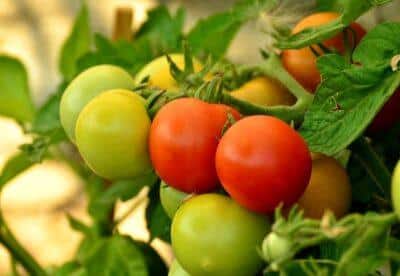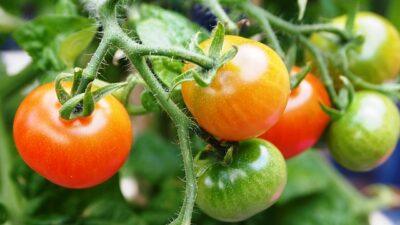We love our tomatoes, those round, colorful gifts from heaven. We stew them, crush them, can them and sauce them. Tomatoes are easy and fun to grow, but like every plant in the garden they can get diseases and become the favorite food of certain bugs. The good news: Most diseases are preventable, and bugs can be repelled.
Let’s look at some of those diseases and bugs and how to prevent them from ruining our tomato harvest.
Common Bugs and Diseases
There are more than 30 types of tomato diseases, but it is unlikely you will ever experience more than three. Commercial tomato growers seem to have more of a problem than the backyard or home gardener. Here is a list of common diseases and bugs, and how you can recognize the issue:
1. Potato Eelworm (Nematodes) – Plants will have stunted growth, and you will notice lumps on the roots.
2. Whitefly – Leaves of the plants will be curling and limp. They will have sticky, black patches on them as well.
3. Tomato Moth – You will notice greenish-brown caterpillars and irregular holes in the leaves of your tomatoes.
The Best Source For Non-GMO Heirloom Seeds Is Right Here!
4. Red Spider Mite – You will see on the underside of the leaves a red mottling design.
5. Leaf Mould – Plants will be brown underneath, with yellow spots on the round leaves.
6. Verticullium Wilt – This disease starts with yellow, wilting leaves. It will eventually spread to the whole plant.
7. Spotted Wilt – You will notice brown spots on leaves, more like a bronze color.
8. Mosaic Virus – This disease causes the plant to have crinkled, yellow leaves.
How to Prevent Tomato Diseases and Bugs Without Chemicals
Healthy plants resist diseases and bugs better and more successful than struggling plants. Calcium is not only important to us, but it’s important to plants, too, and changes in the level of calcium in the soil can affect your tomatoes. It assists with the structure of the plant’s cell walls. Calcium also helps control salts and acids in the plant.
You need to start tomato plants with good fertilizers and soil. You will want to water regularly, but don’t water the foliage. Water only in the morning and avoid the leaves, watering below them. Don’t let the soil dry out, or on the other hand, become waterlogged, as this will cause the plants to become weakened and susceptible to diseases and bugs. Mulching helps control soil splash onto the plant and also controls moisture. Tomatoes need well-drained soil.
It is a good idea to have your plants somewhere with good ventilation (especially at nighttime.) This will reduce humidity. You may remove lower leaves to help with ventilation, but remember not to over-prune. Over-pruning opens the plant to rot. Staking your tomatoes is a good way to promote proper ventilation.
New Natural Fertilizer Doubles Garden Production!
Weed often and keep the area clear of debris, as this will keep insects away and prevent them from finding comfortable places in your garden to make into homes. Rotate your crops every year. Tomatoes should only be in the same spot every four years. By rotating you are preventing soil diseases from developing and staying in the soil. For those gardeners doing indoor tomatoes, change the soil every year.
Remove any unhealthy plants or leaves as soon as you notice them, and keep your gardening tools clean. Do not put unhealthy plants or leaves in the compost. You do not want to put the disease back on your plants! Keep your plants clean, and space them out properly.
Another way to prevent diseases is to purchase disease-resistant tomatoes. Look on the seed packages or seedlings for codes made of letters like V or FFF. Here is a list of codes and what they mean:
V – Verticillium Wilt
TSWV – Tomato Spotted Wilt Virus
F – Fusarium Wilt, Fusarium Wilt 1 and 2
FFF – Fusarium variations, Fusarium wilt 1, 2 and 3
St – Stemphylium (gray leaf spot)
N – Nematodes
T – Tobacco Mosaic Virus
A – Alternaria Alternata (stem canker or early blight)
If you know a disease exists in your area, it may be a good idea to buy tomatoes that are resistant. Or, if you had experience with a disease in your garden before, buying seeds resistant to that particular disease can help avoid any further trouble.
Now that you have the knowledge of common tomato pests and diseases, and ways you can prevent them from even touching your garden, you are well on your way to enjoying a happy and healthy tomato harvest. There is nothing like making your own sauces or dishes with bright, ripe tomatoes from your very own plants.
What are your best tips for keeping tomatoes disease-free? Share your advice in the section below:
Every Year Gardeners Make This Avoidable Mistake — But You Don’t Have To. Read More Here.
 Off The Grid News Better Ideas For Off The Grid Living
Off The Grid News Better Ideas For Off The Grid Living





